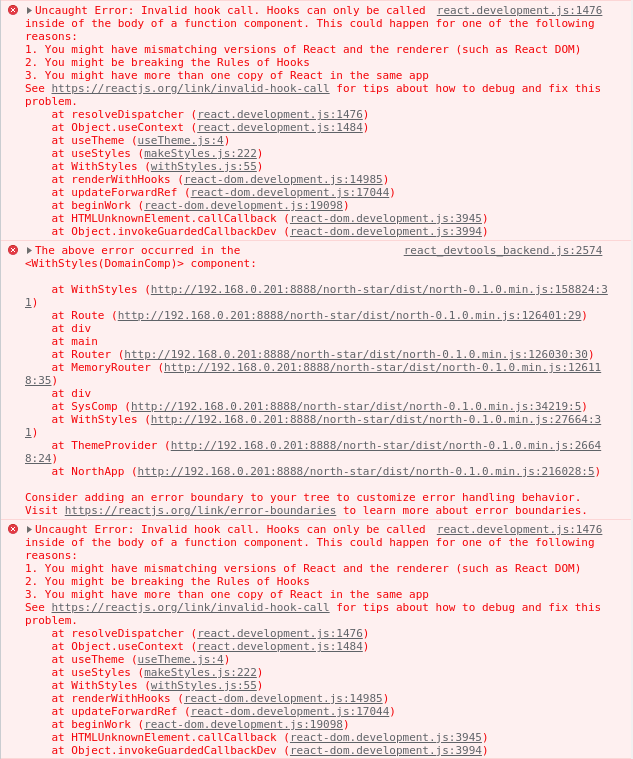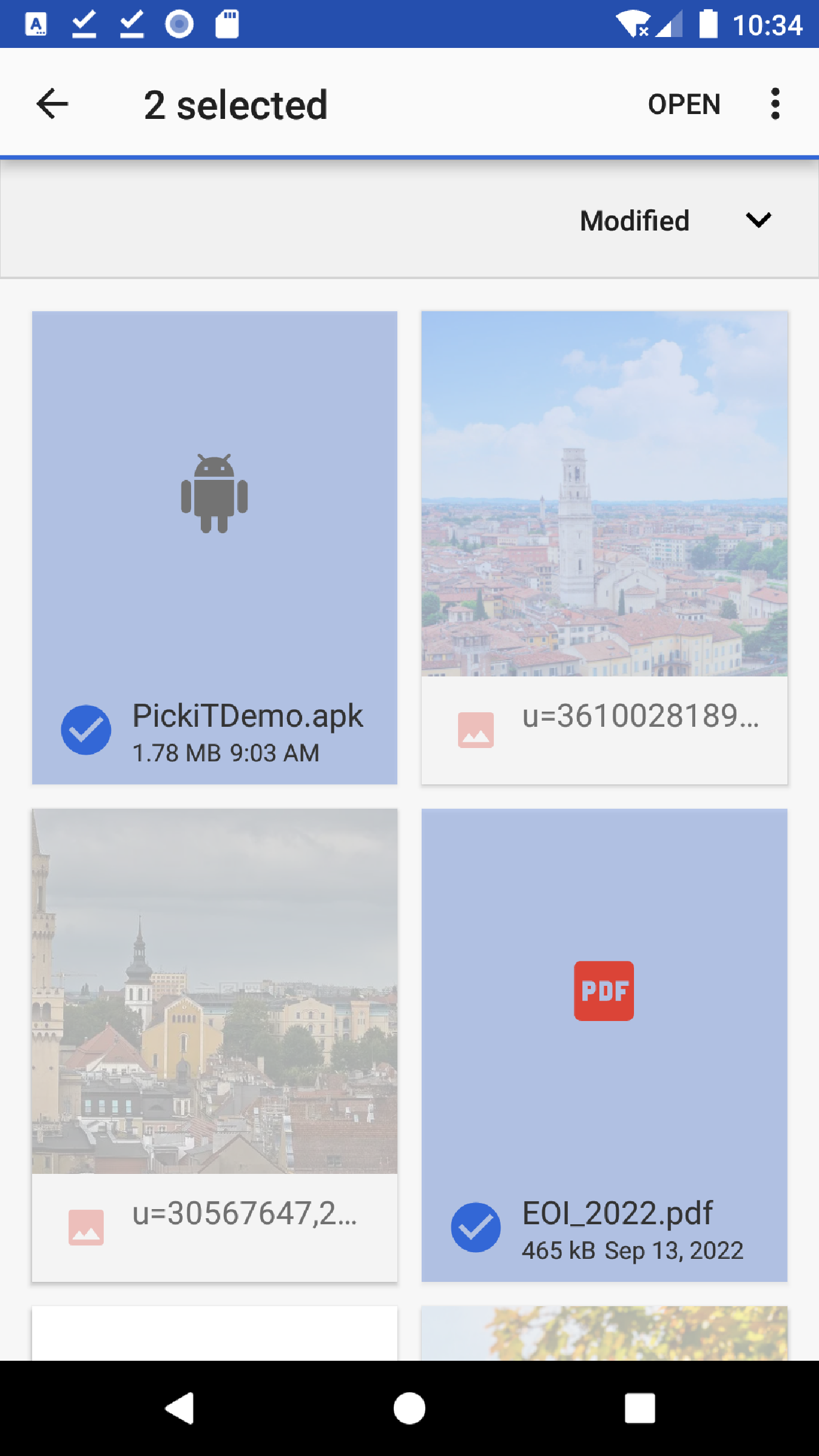Issues & Handling
Invalid hook call
To solve the “Invalid hook call” error and helping example tests, Anclient/js now break into 2 module, @anclient/semantier & @anclient/anreact. ( the next section can be a good example shows how this issue is a big trouble)
For details on structure used to meet independent unit test and test with local npm link.
React Issue #13991 - Invalid hook call
Attention
Since @anclient/react verified, this issue is closed.
Attention
[deprecated] Since new example of North is verified. This issue is closed.
Note
To test with test/jsample, use [ npm link anclient ]
About the error
With webpack transpiled package, both via NPM and minified js, referencing component will reporting error.
NorthApp
|-> AnCliant package
|-> SysComp
| |-> AppBar (Material UI Function)
| |-> WithStyles() (of Material UI)
|-> Sys (withStyle(SysComp))
Error report:

Where AppBar is exported from Material UI, SysComp, extending React.Component, from Anclient.js lib.
The React document didn’t solve this problem, and redirected to issue 13991. Webpack also have similar issue report. See Rreact Document and issues:
Cause of Error
This error is suppressed by resolving react of NorthApp to Anclient’s node_modules/react.
In example.js/north-star/webpack.config.js:
resolve: {
alias: { react: path.resolve('../../../js/node_modules/react') }
},
This can be explained as duplicated react libs been used.
Solution
In Anclient, react, react-dom & material-ui/core are transpiled as external by webpack, see webpack.config.js.
module.exports = {
externals: {
'react': 'react',
'react-dom' : 'reactDOM',
"@material-ui/core": "MaterialUI"
},
...
}
In NorthApp, react & react-dom are installed locally. Then Anclient can be imported like:
import {
an, AnClient, SessionClient, Protocol,
L, Langstrs,
AnContext, AnError, AnReactExt,
Sys, SysComp, Domain, Roles, Orgs, Users
} from 'anclient';
Similar of React Issue #13991
A tried scenario:
publish test/react-app as @anclient/test-react
install anclient in test/react-app
AnContext.anReact is undefined for <QueryForm /> in <Domain />
componentDidMount() {
if (!this.context || !this.context.anReact)
throw new Error('AnQueryFormComp can\'t bind controls without AnContext initialized with AnReact.');
...
}
ReferenceError: regeneratorRuntime is not defined
About the error
When handling D3 with Babel 8.2.2 or later, the async functions requiring regenerator runtime.
There are similar reports like here.
Solution
Follow the answer.
install core-js & regenerator-runtime
npm install --save core-js
npm install --save regenerator-runtime
In histogram.jsx:
import "core-js/stable";
import "regenerator-runtime/runtime";
These 2 steps should solve the problem.
Query Android PDF / Office Files Results Empty
About the issue
On Android 10, API lever 29 (Q) or lower, CursorLoader#on won’t get any files because of the Scoped Storage natural.
CursorLoader:
public class FileLoader extends CursorLoader {
public FileLoader(Context context) {
super(context);
setProjection(FILE_PROJECTION);
if (Build.VERSION.SDK_INT >= Build.VERSION_CODES.Q)
setUri(MediaStore.Files.getContentUri(MediaStore.VOLUME_EXTERNAL));
else
setUri(MediaStore.Files.getContentUri("external"));
setSortOrder(MediaStore.Files.FileColumns.DATE_ADDED + " DESC");
}
}
Usage (with performance issue):
filefilter = new FileFilterx(t, directories -> {
if (isNeedFolderList) {
ArrayList<Directory> list = new ArrayList<>();
Directory all = new Directory();
all.setName(getResources().getString(R.string.vw_all));
list.add(all);
list.addAll(directories);
mFolderHelper.fillData(list);
}
loadirs(directories); // parse files, can't find files other than medias
});
filefilter.filter(this, suffix);
Reference:
[1] Data and file storage overview, DOCUMENTATION at developers ,
[2] Android API Level and Cumulative Usage, apilevels.com
- [3] Grant access to a directory’s contents, Access documents and other files from shared storage
[4] Android Developers, Storage access with Android 11, Youtube
[5] HBiSoft, PickiT
[8] Manage all files on a storage device
But Google Play has a restrict policy :
If your app meets the policy requirements for acceptable use or is eligible for an exception, you will be required to declare this and any other high-risk permissions using the Permissions Declaration Form in Play Console.
Decision
Let users pick local files then match the results with pushed records.
Sample App: PickiT

Using Grant access to a directory’s contents and disable the function lower than API 21.
What’s next
Try on Android 11.
See [4], [6] & [7].
Code snipet of [6]:
List<String> getPdfList(
Uri collection, // MediaStore.Downloads.getContentUri("external")
String[] projection, // result list's columes index
String selection, // mime of pdf
String[] selectionArgs, // mime
String sortOrder) {
List<String> pdfList = new ArrayList<>();
try (Cursor cursor = getContentResolver().query(collection, projection, selection, selectionArgs, sortOrder)) {
assert cursor != null;
if (cursor.moveToFirst()) {
int columnData = cursor.getColumnIndex(MediaStore.Files.FileColumns.DATA);
do {
pdfList.add((cursor.getString(columnData)));
Log.d(TAG, "getPdf: " + cursor.getString(columnData));
//you can get your pdf files
} while (cursor.moveToNext());
}
}
return pdfList;
}
Nginx Request Size Limit
About the issue
Nginx reverse proxy by default will limit the request’s body size [1], which will result in failure of pushing blocks. Block size currently is a hard coded parameter. Returned http code for this is 413 [#ref2].
TODO: Best Practice
Multiple Nginx proxy example [#ref3]:
http {
# Server B
server {
listen 127.0.0.1:5001;
server_name 127.0.0.1;
location / {
proxy_pass http://127.0.0.1:5000;
}
}
# Server A
server {
listen 4999;
server_name domain.com;
location / {
proxy_pass http://127.0.0.1:5001;
proxy_set_header X-Forwarded-User 'username';
}
}
}
Resposnse Header:
GET / HTTP/1.0
Host: 127.0.0.1:5000
Connection: close
...
X-Forwarded-User: username
User-Agent: curl/7.58.0
Accept: */*
X-size: 20M
X-size: 30M
...
Apache Tika behave different in Eclipse & Docker
About the issue
For short, external tika parser configured can not working correctly.
Since jserv-album 0.6.50, a test case, ExifTest#testTika is added to check this problem, which can work differently in different environment. The correct output of Exif#init(String) should like this:
[Exif.init] Loading tika configuration:
/home/ody/d/git/semantic-jserv/jserv-album/src/main/webapp/WEB-INF/tika.xml
SLF4J: No SLF4J providers were found.
SLF4J: Defaulting to no-operation (NOP) logger implementation
SLF4J: See https://www.slf4j.org/codes.html#noProviders for further details.
ERROR StatusLogger Log4j2 could not find a logging implementation. Please add log4j-core to the classpath. Using SimpleLogger to log to the console...
[Exif.init] Tika config:
[application/vnd.ms-htmlhelp, message/rfc822, application/vnd.visio, application/atom+xml, image/x-xcf, image/wmf, audio/midi, ...
[Exif.init] Parser for video/mp4: org.apache.tika.parser.ParserDecorator$1,
declared (supported types):[video/mp4]
[Exif.init] ------------ Exteranl tika parser configured for vide/mp4 --------------
video/avi, org.apache.tika.parser.external.ExternalParser@4a07d605
video/mpeg, org.apache.tika.parser.external.ExternalParser@4a07d605
video/x-msvideo, org.apache.tika.parser.external.ExternalParser@4a07d605
video/mp4, org.apache.tika.parser.external.ExternalParser@4a07d605
The last a few lines is the diagnose of an external parser configured in WEB-INF/tika.xml.
In Album 0.2.2, the external parser, i.e. org.apache.tika.parser.external.CompositeExternalParser, is configured as:
<?xml version="1.0" encoding="UTF-8"?>
<properties>
<parsers>
<parser class="org.apache.tika.parser.DefaultParser">
</parser>
<parser class="org.apache.tika.parser.mp4.MP4Parser">
<mime-exclude>video/mp4</mime-exclude>
</parser>
<parser class="org.apache.tika.parser.external.CompositeExternalParser">
<mime>video/mp4</mime>
</parser>
</parsers>
</properties>
This can cause error when running in docker. The secret for this is the parser is actually based on external tools.
How does ExternalParser working?
The external parser is loaded by ExternalParsersFactory, according to configuration located in jar:tika-core-2.8.0.jar!tika-externals.xml
<?xml version="1.0" encoding="UTF-8"?>
<external-parsers>
<!-- This example uses ffmpeg for video metadata extraction -->
<parser>
<check>
<command>ffmpeg -version</command>
<error-codes>126,127</error-codes>
</check>
<command>ffmpeg -i ${INPUT}</command>
<mime-types>
<mime-type>video/avi</mime-type>
<mime-type>video/mpeg</mime-type>
<mime-type>video/x-msvideo</mime-type>
</mime-types>
<metadata>
<match key="xmpDM:audioSampleRate">\s*Stream.*:.+Audio:.*,\s+(\d+)\s+Hz,.*</match>
<match key="xmpDM:audioChannelType">\s*Stream.*:.+Audio:.*\d+\s+Hz,\s+(\d{1,2})\s+channels.*</match>
<match key="xmpDM:audioCompressor">\s*Stream.*:.+Audio:\s+([A-Za-z0-9_\(\)/\[\] ]+),.*</match>
<match key="xmpDM:duration">\s*Duration:\s*([0-9:\.]+),.*</match>
<match key="xmpDM:fileDataRate">\s*Duration:.*,\s*bitrate:\s+([0-9A-Za-z/ ]+).*</match>
<match key="xmpDM:videoColorSpace">\s*Stream.*:\s+Video:\s+[A-Za-z0-9\(\)/ ]+,\s+([A-Za-z0-9\(\) ,]+),\s+[0-9x]+,.*</match>
<match key="xmpDM:videoCompressor">\s*Stream.*:\s+Video:\s+([A-Za-z0-9\(\)/ ]+),.*</match>
<match key="xmpDM:videoFrameRate">\s*Stream.*:\s+Video:.*,\s+([0-9]+)\s+fps,.*</match>
<match key="encoder">\s*encoder\s*\:\s*(\w+).*</match>
<match key="videoResolution">\s*Stream.*:\s+Video:.*,\s+([0-9x]+),.*</match>
</metadata>
</parser>
<parser>
<check>
<command>exiftool -ver</command>
<error-codes>126,127</error-codes>
</check>
<command>env FOO=${OUTPUT} exiftool ${INPUT}</command>
<mime-types>
<mime-type>video/avi</mime-type>
<mime-type>video/mpeg</mime-type>
<mime-type>video/x-msvideo</mime-type>
<mime-type>video/mp4</mime-type>
</mime-types>
<metadata>
<match>\s*([A-Za-z0-9/ \(\)]+\S{1})\s+:\s+([A-Za-z0-9\(\)\[\] \:\-\.]+)\s*</match>
</metadata>
</parser>
</external-parsers>
The constructor of CompositeExternalParser as configured above uses a factory to check and load the parser, which is actually using java runtime.exec() to call the configured commands, with org.apache.tika.parser.external.ExternalParsersConfigReader parsing the xml file.
- ::
- TikaConfig.init() ->
- XmlLoader.loadOverAll() -> loadOne() ->
- ParserXmlLoader.createComposit() ->
… new CompositeExternalParser() ->
- ExternalParsersFactory.create() ->
- ExternalParsersConfigReader.read(element) -> // element: xml/external-parsers
- ExternalParsersConfigReader.readCheckTagAndCheck() ->
ExternalParser.check()
The check commands is run at loading,
public class ExternalParser extends AbstractParser {
// This line explain why no tika error output if the tool is missing.
private static final Logger LOG = LoggerFactory.getLogger(ExternalParser.class);
public static boolean check(String[] checkCmd, int... errorValue) {
if (errorValue.length == 0) {
errorValue = new int[]{127};
}
Process process = null;
try {
process = Runtime.getRuntime().exec(checkCmd);
Thread stdErrSuckerThread = ignoreStream(process.getErrorStream(), false);
Thread stdOutSuckerThread = ignoreStream(process.getInputStream(), false);
stdErrSuckerThread.join();
stdOutSuckerThread.join();
//make the timeout parameterizable
boolean finished = process.waitFor(60000, TimeUnit.MILLISECONDS);
if (!finished) {
throw new TimeoutException();
}
int result = process.exitValue();
LOG.debug("exit value for {}: {}", checkCmd[0], result);
for (int err : errorValue) {
if (result == err) {
return false;
}
}
return true;
}
catch (Exception e) {
LOG.debug("exception trying to run " + checkCmd[0], e);
return false;
}
}
}
The parsing command is called by user,
// cmd instance: [env, FOO=/tmp/apache-tika-9023966031715135711.tmp, exiftool, /tmp/apache-tika-4419354677653382044.tmp]
private void parse(TikaInputStream stream, XHTMLContentHandler xhtml, Metadata metadata) {
...
if (cmd.length == 1) {
process = Runtime.getRuntime().exec(cmd[0]);
} else {
process = Runtime.getRuntime().exec(cmd);
}
}
Load exiftool in Windows
The problem is the checking and running command connfigured in package org.apache.tika.parser.external, in tika-external-parsers.xml, won’t work in Windows.
The jserv-album way
Replace ExternalParsersFactory.create():
if (windows) {
filepath = new File(filepath).getAbsolutePath();
return create(new File(filepath).toURI().toURL());
}
The give user a chance to configure the file.